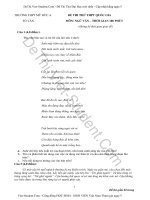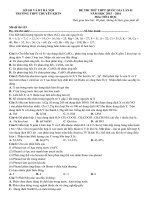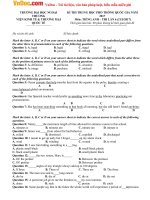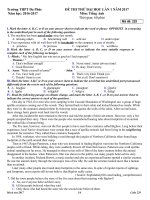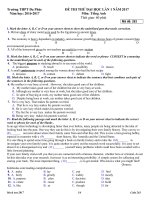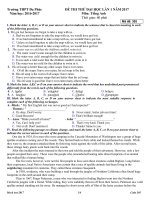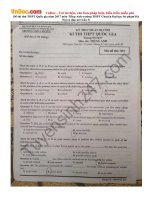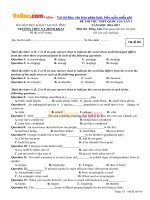Đề thi thử vào lớp 10 môn Tiếng Anh năm 2019 - 2020 sở Hà Nội có đáp án - Lần 1 | Tiếng Anh, Đề thi vào lớp 10 - Ôn Luyện
Bạn đang xem bản rút gọn của tài liệu. Xem và tải ngay bản đầy đủ của tài liệu tại đây (154.71 KB, 15 trang )
<span class='text_page_counter'>(1)</span><div class='page_container' data-page=1>
Đề thi thử theo mẫu của SGD Hà Nội
<b>Choose the word which has the underlined part pronounced from the others.</b>
<b>Question 1: </b>
A. Watched
B. Stopped
<b>C. Needed</b>
D. Fixed
<i>Giải thích: </i>
<i>Từ "need" kết thúc bằng âm /d/ => đuôi -ed thêm vào được phát âm thành âm /id/.</i>
<i>Các từ "watch", "stop", "fix" kết thúc bằng các âm không rung lần lượt là /tʃ/, /p/,/s/ =></i>
<i>đuôi -ed thêm vào được phát âm thành âm không rung /t/.</i>
<b>Question 2:</b>
A. Family
B. Can
C. Graduate
<b>D. Party</b>
<i>Giải thích: </i>
<i>Chữ a trong từ party được phát âm là /ɑː/, trong khi các từ khác được phát âm</i>
<i>là /æ/. </i>
<b>Choose the word that differs from the other three in the position of primary</b>
<b>stress.</b>
<b>Question 3:</b>
A. Destroy
B. Appear
<b>C. Happen</b>
D. Provide
<i>Giải thích:</i>
</div>
<span class='text_page_counter'>(2)</span><div class='page_container' data-page=2>
<i>- động từ "happen" có âm thứ 2 chứa nguyên âm ngắn /ə/ => trọng âm rơi vào âm</i>
<i>tiết thứ nhất.</i>
<b>Question 4:</b>
A. Weather
B. Public
<b>C. Cartoon</b>
D. Distance
<i>Giải thích:</i>
<i>- "weather", "public", "distance" là các danh từ 2 âm tiết => trọng âm rơi vào âm tiết</i>
<i>thứ 1. </i>
<i>- danh từ "cartoon" có âm thứ 2 chứa nguyên âm dài /uː/ => trọng âm rơi vào âm</i>
<i>tiết thứ 2.</i>
<b>Choose the underlined part that needs correction in each of the following</b>
<b>questions.</b>
<b>Question 5</b>
If I have many homework to do, I will not be able to attend the meeting.
<b>A. Many</b>
B. To do
C. Will not
D. Attend
<i>Giải thích: </i>
<i>Vì "homework" là danh từ khơng đếm được => "many" phải đổi thành "much". Dịch: </i>
<i>Nếu tơi có nhiều bài tập về nhà phải làm, tơi sẽ không thể tham gia buổi gặp gỡ.</i>
<i>Chủ điểm liên quan</i>
<b>Question 6: </b>
Unfortunately, the catering committee can never agree between themselves.
A. Unfortunately
B. The
</div>
<span class='text_page_counter'>(3)</span><div class='page_container' data-page=3>
<i>Giải thích: </i>
<i>Committee (n.): hội đồng - bao gồm nhiều người => Sửa "between" (giữa/trong 2</i>
<i>người) thành "among" giữa nhiều người, nhiều đối tượng </i>
<i>Dịch: Khơng may là ủy ban hậu cần khó mà đạt được sự đồng thuận giữa chính</i>
<i>họ.</i>
<b>Question 7: </b>
John always arrives lately for his chemistry class even though he leaves his
dormitory in plenty of time.
A. Leaves
<b>B. Lately</b>
C. Always
D. In plenty of time
<i>Giải thích: </i>
<i>Lately (adv.): gần đây late (adj./adv.): muộn => Sửa "lately" thành "late". Dịch: John</i>
<i>ln đến lớp Hóa của mình muộn mặc dù anh ấy rời khỏi ký túc xá sớm.</i>
<b>Question 8: </b>
Everyone was exhausted and hungry, _____ they sat down under the tree and had a
snack.
<b>A. So</b>
B. So that
C. Since
D. Because of
<i>Giải thích:</i>
<i>so + clause: vì thế </i>
<i>so that + clause: để mà </i>
<i>since + clause ~ because of + N/V-ing: bởi vì </i>
<i>Dịch: Mọi người đều kiệt sức và đói, vì thế họ ngồi xuống dưới gốc cây và ăn nhẹ.</i>
<b>Question 9: </b>
</div>
<span class='text_page_counter'>(4)</span><div class='page_container' data-page=4>
<b>A. discovered </b>
<b>B. has discovered </b>
<b>C. was discovering </b>
<b>D. discovers</b>
<i><b>Giải thích:</b></i>
<i>Cuối câu có cụm trạng ngữ chỉ thời gian với "ago" => động từ chia ở thì quá khứ</i>
<i>đơn. Dịch: Christopher Columbus đã khám phá ra châu Mỹ hơn 500 năm trước. </i>
<b>Question 10: </b>
How _____ milk do you want?
A. old
<b>B. much </b>
C. many
D. any
<i>Giải thích: </i>
<i>Câu hỏi về danh từ không đếm được "milk" </i>
<i>=> Dùng cấu trúc: How much + N (không đếm được)...?: Bao nhiêu...? </i>
<i>Dịch: Bạn muốn bao nhiêu sữa? </i>
<b>Question 11: </b>
The United States’ Library of Congress is one of the _____ libraries in the world.
<b>A. larger </b>
<b>B. largest </b>
C. larger than
D. large
<i>Giải thích: </i>
<i>So sánh hơn nhất dùng để so sánh người (hoặc vật) với tất cả người (hoặc vật)</i>
<i>trong nhóm. </i>
<i><b>Cấu trúc so sánh hơn nhất với tính từ ngắn: S + to be + the + adj + est + Noun/</b></i>
<i><b>Pronoun. </b></i>
</div>
<span class='text_page_counter'>(5)</span><div class='page_container' data-page=5>
<b>Question 12: </b>
On the way to the office, he often stops _______ a newspaper.
<b>A. to buy </b>
B. buying
C. buy
D. having bought
<i>Giải thích: </i>
<i>Dịch: Trên đường đến văn phòng, anh ấy thường dừng lại để mua một tờ báo. </i>
<i>stop to do sth: dừng lại để làm việc gì </i>
<i>stop doing sth: dừng việc gì đang làm lại </i>
<b>Question 13: </b>
Let’s go to our country. It looks beautiful ______ spring.
A. for
<b>B. in </b>
C. on
D. at
<i>Giải thích:</i>
<i>Giới từ "in" được dùng với khoảng thời gian dài như: mùa (spring, summer,</i>
<i>autumm, winter), tháng, năm... </i>
<i>Dịch: Hãy đến nước chúng tơi. Vào mùa xn, nó rất đẹp. </i>
<b>Question 14: </b>
She wishes she _____ a sister. She has four brothers but no sisters!
A. have
B. has
<b>C. had </b>
D. will have
<i>Giải thích:</i>
</div>
<span class='text_page_counter'>(6)</span><div class='page_container' data-page=6>
<i>Dịch: Cơ ấy ước rằng mình có một người chị gái. Cơ ấy có bốn anh trai nhưng</i>
<i>khơng có chị gái nào cả. </i>
<b>Question 15 </b>
Jane _____ for the telephone company, but now she has a job at the post office.
A. used to working
<b>B. used to work </b>
C. is used to working
D. am used to work
<i>Giải thích: </i>
<i>“used to” + V(inf.): đã từng => thói quen trong q khứ, giờ khơng cịn nữa.</i>
<i>Dịch: Jane từng làm việc cho một công ty điện thoại, nhưng bây giờ cô ấy làm việc</i>
<i>ở bưu điện.</i>
<b>Question16: </b>
My sister has a very large _______ of books.
A. collect
<b>B. collection </b>
C. collector
D. collective
<i>Giải thích: </i>
<i><b>Cấu trúc của một cụm danh từ số ít thường gặp: Mạo từ + tính từ + danh từ</b></i>
<i>Từ cần điền đứng sau "a + adj" và trước giới từ "of". </i>
<i>=> Ta cần 1 danh từ. a (large) collection of sth: một bộ sưu tập ...(lớn) </i>
<i>Dịch: Chị tơi có một bộ sưu tập sách đồ sộ.</i>
<b>Choose the correct response. </b>
<b>Question 17: </b>
“Mom, I’ve got the first rank in class this semester!” “_______________.”
<b>A. Well done! </b>
</div>
<span class='text_page_counter'>(7)</span><div class='page_container' data-page=7>
D. Let’s go!
<i>Giải thích: </i>
<i>Dịch: </i>
<i>- Mẹ ơi, con đứng đầu lớp học kỳ này đấy. </i>
<i>- Con làm tốt lắm.</i>
<b>Question 18: </b>
“Would you like to have dinner with me?” - “_____.”
<b>A. Yes, I’d love to </b>
B. Yes, it is
C. Yes, I hope so
D. Yes, so do I
<i>Giải thích: </i>
<i>Dịch: </i>
<i>- Bạn có muốn đi ăn tối với tơi khơng? </i>
<i>- Có chứ, tơi rất sẵn lịng.</i>
<b>Question 19: Choose the word CLOSEST in meaning to the underlined word. </b>
Heavy rain makes driving on the road very difficult.
<b>A. hard </b>
B. easy
C. interesting
D. simple
<i>Giải thích:</i>
<i>Mưa lớn làm cho việc lái xe trên đường rất khó khăn. </i>
<i>hard (adj) ~ difficult (adj): khó khăn, vất vả</i>
<b>Question 20: Choose an option to indicate the word(s) CLOSEST in meaning</b>
<b>to the underlined word(s). </b>
I just want to stay at home, watch television and take it easy.
A. sleep
</div>
<span class='text_page_counter'>(8)</span><div class='page_container' data-page=8>
<b>C. relax </b>
D. do easy things
<i>Giải thích: </i>
<i>Dịch: Tơi chỉ muốn ở nhà, xem tivi và thư giãn. </i>
<i>take it easy (idm.): sống từ từ, thoải mái ~ relax (v): thư giãn</i>
<b>Question 21: Choose an option to indicate the word(s) OPPOSITE in meaning</b>
<b>to the underlined word(s). </b>
I'm so grateful to you for looking after my cat last week. The word which is
opposite in meaning to the underlined word is _____.
A. pleased
B. pretty
C. welcome
<b>D. thankless</b>
<i>Giải thích: </i>
<i>grateful (adj.): biết ơn >< thankless (adj.): vô ơn </i>
<i>pleased (adj.): hài lịng </i>
<i>pretty (adj.): đẹp </i>
<i>welcome (adj.): hoan nghênh </i>
<i>Dịch: Tơi rất biết ơn cậu vì đã chăm sóc con mèo của tôi tuần trước.</i>
<b>Question 22: Choose the word(s) OPPOSITE in meaning to the underlined</b>
<b>word(s). </b>
The average cost of a new house has gone up by five percent to £276,500.
<b>A. decreased </b>
B. increased
C. depressed
D. relieved
<i>Giải thích: </i>
</div>
<span class='text_page_counter'>(9)</span><div class='page_container' data-page=9>
<i>go up: tăng lên >< decrease: giảm xuống</i>
<b>Question 23: Choose the correct answer from the options below to complete</b>
<b>the passage.</b>
Today, supermarkets are found in almost every large city in the world. But the
<b>first supermarket 1 (were, was, is, has been) opened only fifty years ago. It was</b>
opened only fifty years ago. It was opened in New York by a man named Michael
<b>Cullen. A supermarket is different 2 (from, with, of, in) other types of stores in</b>
<b>several ways. In supermarkets, goods are placed on open shelves. The 3 (assistants,</b>
<b>managers, customers, sellers) choose what they want and take them to the</b>
checkout counter. This means that fewer shop assistants are needed than in other
stores. The way products are displayed is another difference between supermarkets
<b>and many other types of stores; 4 (by, of, in, for) example, in supermarkets, there</b>
is usually a display of small inexpensive items just in front of the checkout
counter: candies, chocolates, magazines, cheap foods and so on. Most customers
going to a supermarket buy goods from a shopping list. They know exactly what
<b>they need to buy. They 5 (make, go out, do, go) the shopping according to a plan.</b>
<i>Giải thích:</i>
<i>1. Chủ ngữ "the first supermarket" thụ hưởng hành động "open" => động từ chia ở</i>
<i>dạng bị động sau chủ ngữ số ít. </i>
<i><b>Trong câu có cụm "fifty years ago" => động từ chia ở thì quá khứ đơn: S +</b></i>
<i><b>was/were + V(pp) </b></i>
<i>2. different from sb/sth: khác với </i>
<i>3. customer (n.): Khách hàng "The customers choose what they want and take them</i>
<i>to the checkout counter.": Khách hàng chọn những gì họ muốn và đưa đến quầy</i>
<i>thanh tốn. </i>
<i>4. For example: ví dụ </i>
<i>5. do the shopping: đi mua sắm</i>
<b>Read the passage and choose the correct answer to each of the questions. </b>
</div>
<span class='text_page_counter'>(10)</span><div class='page_container' data-page=10>
Puberty doesn’t happen all at once — it comes in stages and takes many years.
You might have some signs of puberty at an early age, while other changes show
up years later. Bodies are unique, so puberty is different for each person. Everyone
<b>goes through puberty at their own pace. </b>
Puberty is a normal part of life. But it’s still common to feel anxious, excited,
and confused about it. Knowing what to expect can make puberty changes seem
less weird or stressful. And talking to your parents or other adults you trust also
helps. After all, they’ve gone through puberty too. So they probably understand
how you feel, and have good advice.
Puberty can be a very confusing time in your life. Therefore, finding activities
that are fun and healthy can help you deal with stress and your feelings, and release
extra energy. Physical activity, writing, music, art, or talking with friends are great
ways to express your emotions and feel good about yourself.
<b>Question 24:</b>
What does the passage mainly discuss?
A. Becoming adult
B. Changes in body
<b>C. Puberty </b>
D. The difference between males and females at puberty
<i>Giải thích: </i>
<i>Câu đầu mỗi đoạn:</i>
<i>- Puberty is the time when you physically become an adult. </i>
<i>- Puberty doesn’t happen all at once.</i>
<i>- Puberty is a normal part of life.</i>
<i>- Puberty can be a very confusing time in your life.</i>
<b>Question 25:</b>
When does puberty often begin?
A. At an early age
B. A different age
<b>C. Between the age of eight and fourteen </b>
D. When you are an adolescence
</div>
<span class='text_page_counter'>(11)</span><div class='page_container' data-page=11>
<i>Câu 4 đoạn 1: People usually start going through puberty between ages eight and</i>
<i>fourteen.</i>
<b>Question 26: </b>
What emotion(s) will one person experience during puberty time?
<b>A. anxious, excited, and confused </b>
B. anxious and confused
C. excited and confused
D. anxious, excited, happy and confused
<i>Giải thích: </i>
<i>Câu 2 đoạn 3: But it’s still common to feel anxious, excited, and confused about it.</i>
<b>Question 27: </b>
Who can teenagers talk to when they are in their puberty time?
A. friends
B. adults
C. parents
<b>D. parents or other adults</b>
<i>Giải thích: </i>
<i>Câu 4 đoạn 3: And talking to your parents or other adults you trust also helps.</i>
<b>Question 28:</b>
The word "pace" is closest in meaning to _________.
A. style
<b>B. speed </b>
C. way
D. time
<i>Giải thích: </i>
<i>Everyone goes through puberty at their own pace: Mọi người đều trải qua tuổi dậy</i>
<i>thì với tốc độ của riêng mình. </i>
</div>
<span class='text_page_counter'>(12)</span><div class='page_container' data-page=12>
<b>Question 29: Rewrite the sentence so that it has a similar meaning to the</b>
<b>original one. </b>
I last ate raw fish when I was in Japan.
=> I haven't ...
<i>Đáp án: </i>
<i>I haven't eaten raw fish since I was in Japan.</i>
<i>Giải thích: </i>
<i>Câu gốc: Lần cuối tơi ăn cá sống là khi tơi cịn ở Nhật. ~ Tơi đã khơng ăn cá sống</i>
<i>kể từ sau khi tôi ở Nhật. </i>
<i>Câu viết lại sử dụng hiện tại hồn thành mơ tả hành động bắt đầu trong quá khứ</i>
<i>và kéo dài đến thời điểm hiện tại. </i>
<i><b>Cấu trúc: S + have/ has + V (pp) + since + thời gian. </b></i>
<b>Question 30: Rewrite the sentence so that it is closest in meaning to the given</b>
<b>one. </b>
They built a supermarket near the airport last year.
=> A supermarket ...
<i>Đáp án: </i>
<i>A supermarket was built near the airport last year.</i>
<i>Giải thích: </i>
<i>Câu gốc: Họ đã xây dựng một siêu thị gần sân bay năm ngoái. ~ Một siêu thị đã</i>
<i>được xây dựng gần sân bay năm ngoái. </i>
<i>Chủ ngữ "A supermarket" thụ hưởng hành động "build". => câu viết ở thể bị động của</i>
<i>quá khứ đơn. </i>
<i><b>Cấu trúc: S + be (pt) + V (pp) + ... </b></i>
<b>Question 31: </b>
</div>
<span class='text_page_counter'>(13)</span><div class='page_container' data-page=13>
=> Mary suggested ...
Đáp án:
- Mary suggested that we should go somewhere for a change.
- Mary suggested going somewhere for a change.
<i>Giải thích: </i>
<i>Cấu trúc với suggest: </i>
<i><b>S1 + suggest + (that) + S2 + (should) + V (inf) + ... hoặc: S + suggest + V-ing</b></i>
<i><b>+ ... </b></i>
<i>Dịch: "Tại sao chúng ta khơng đi đâu đó để thay đổi khơng khí nhỉ?" Mary nói. </i>
<i>~ Mary đề nghị chúng tơi đi đâu đó để thay đổi khơng khí. </i>
<b>Question 32: Complete the new sentence so that it has the same meaning as</b>
<b>the first 2 sentences. </b>
I don’t have enough money. I can’t buy my favorite book.
=> If ...
<i>Đáp án: </i>
<i>If I had enough money, I could buy my favorite book.</i>
<i>Giải thích: </i>
<i>Dịch: Tơi khơng có đủ tiền. Tơi khơng thể mua cuốn sách u thích của tơi. </i>
<i>~ Nếu tơi có đủ tiền, tơi có thể mua cuốn sách u thích của mình. </i>
<i>Câu viết lại giả sử một điều khơng có thực ở hiện tại </i>
<i>=> Sử dụng câu điều kiện loại 2: diễn tả điều kiện khơng có thật ở hiện tại. </i>
<i><b>Cấu trúc: If + S + V (pt), S + would/could/might + V (inf) </b></i>
<b>Question 33: Complete the second sentence using the word given so that it has</b>
<b>the same meaning to the first. </b>
The man is very strong. He can lift that heavy table. (ENOUGH)
<i>Đáp án: </i>
</div>
<span class='text_page_counter'>(14)</span><div class='page_container' data-page=14>
<i>Giải thích: </i>
<i><b>Cấu trúc: S + to be + adj. + enough + (for sb) + to V (inf): đủ… để… </b></i>
<i>Dịch: Người đàn ông đó rất khỏe. Anh ta có thể nâng cái bàn nặng đó. </i>
<i>~ Người đàn ơng đó đủ khỏe để có thể nâng cái bàn nặng đó. </i>
<b>Question 34: Complete the second sentence so that it has a similar meaning to</b>
<b>the first sentence, using the word in brackets. </b>
Losing weight is not so easy as putting on weight. (DIFFICULT)
<i>Đáp án: </i>
<i>Losing weight is more difficult than putting on weight.</i>
<i>Giải thích: </i>
<i><b>Cấu trúc so sánh hơn với tính từ dài: S + be + more + Adj + than + N/V-ing. </b></i>
<i>Câu gốc: Giảm cân không dễ dàng như tăng cân. => Giảm cân khó hơn tăng cân. </i>
<b>Question 35: Complete the second sentence using the word given so that it has</b>
<b>the same meaning to the first. </b>
He tried hard. He couldn't set up a new world record. (ALTHOUGH)
<i>Đáp án: </i>
<i>Although he tried hard, he couldn't set up a new world record. He couldn't set up a</i>
<i>new world record although he tried hard</i>
<i>Giải thích: </i>
<i>although + clause: mặc dù </i>
<i>Dịch: Anh ấy đã cố gắng hết sức. Anh ấy không thể thiết lập một kỷ lục thế giới</i>
<i>mới. => Mặc dù anh ấy đã cố gắng hết sức, anh ấy không thể thiết lập một kỷ lục</i>
<i>thế giới mới. </i>
<b>Question 36: Combine two sentences into a new one using the given words in</b>
<b>brackets. Do not change the given words in any ways. </b>
A man had put his arm through the window of a house and stolen some money.
The money was lying on a table inside. (which)
</div>
<span class='text_page_counter'>(15)</span><div class='page_container' data-page=15></div>
<!--links-->
